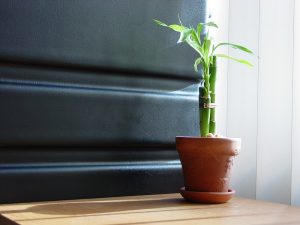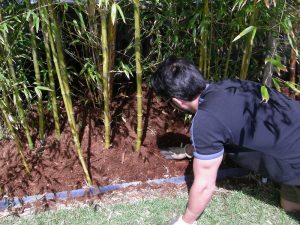Bamboo makes for one of the more interesting houseplants. It’s decorative, hardy and can spread like wildfire, so it makes for a beautiful but challenging plant.
Preparing the pot is the first step. Though there are dwarf species, regular bamboo can grow to enormous heights. But the first few years will only see a few feet and the bamboo can be trimmed. So, select a medium-sized pot.

Soil preparation is next. Bamboo enjoys somewhat acidic soil with very good drainage. pH can be measured with a soil testing kit. Loamy earth with not much clay will serve well. You can mulch the surface heavily and seed the pot with earthworms to let them decay the leaves and make holes for good aeration. Just spread a couple of inches of mulch around the top.

Later, when the bamboo begins to shed leaves, just let them lie on the surface over the roots and rhizomes. They’ll help keep the soil moist, which bamboo – since it grows naturally in highly humid climates – really needs.
Groundcover can be a good addition to the surface as well. You want something that is high in nitrogen and silica, two things the bamboo needs in quantity for good health. Some gardeners will use chicken manure to supply a high quantity of nutrients, but the odor isn’t something that most will want around the house. If the bamboo is kept in a pot on the porch, however, it might serve the purpose.
Bamboo can be planted at any time of the year in milder climates, but in colder areas aim for mid-spring. Planting later won’t give the bamboo enough time to establish itself well before the cold weather sets in. Even when kept indoors in temperature controlled conditions, bamboos are usually near the window. The cold surface of the window often draws heat away from the plant. You can counteract that somewhat by mulching heavily.
Remember that, since bamboo can spread readily, you will need to be careful of the plant becoming root bound. A large pot will help, but be prepared to re-pot. Often a smaller species is used to slow the process down. Some gardeners will use a long planter box rather than a round pot, in order to make for a nice row of plants.
Proper watering practice is critical for container-grown bamboo. Because of the geography in which it evolved, bamboo does not tolerate dry soil well. Yet, the soil can’t be continually sopping wet, either. Maintaining that balance will require experimentation and careful observation to ensure the plant is staying healthy.
Newly planted bamboo requires more frequent watering. Twice a week is common, where other plants do better with only once per week. In a five gallon pot about a 1/2 gallon of water is called for. More frequent watering will likely damage the plant, as evidenced by excessive leaf dropping. However, in Spring the leaves will yellow and fall, which is normal.
